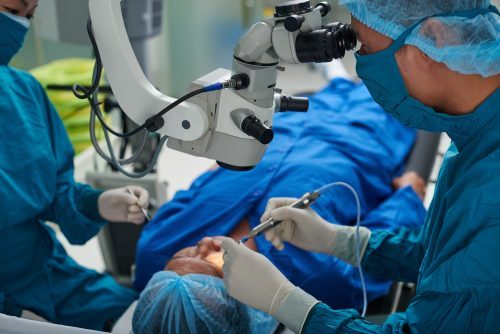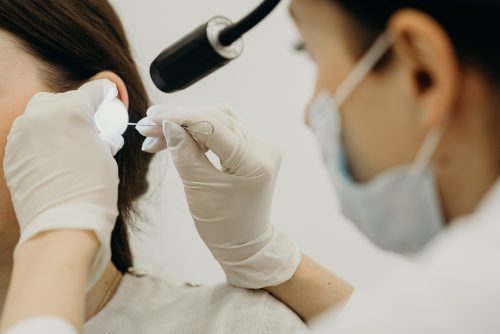Did you know Mass Eye and Ear has an emergency department available 24/7 for any eye, ear, nose and throat (ENT) emergencies? Focus spoke with three members of the emergency department, Elise Lippmann, MD, Grayson Armstrong, MD, MPH and Margot Weinert, MD to decipher when to utilize this unique resource.
Mass Eye and Ear provides the only 24-hour, 7 days-a-week emergency department (ED) in New England for treating conditions of the eye, ear, nose, throat, head and neck. This unique resource is one of a few specialized emergency departments in the entire country and is part of the reason why Boston is a leader in medical care.
Although the Mass Eye and Ear ED welcomes and sees all patients, it’s important to remember it is an emergency room and not an urgent care clinic. To ensure the ED is best utilized, Focus spoke with ENT specialist, Elise Lippmann, MD, eye emergency physician-surgeon, Grayson Armstrong, MD, MPH, and ocular trauma specialist, Margot Weinert, MD, who shared their insights on which conditions require emergency treatment and what may be treated elsewhere.
Which conditions are classified as emergencies?
There is a wide array of conditions that are classified as eye and ENT emergencies, and it can be extremely challenging to decide when to go to the emergency room.

ENT emergencies include the following acute conditions: ear infections that do not respond to current or prior treatments, or infections associated with high fevers or weakness of the face; nosebleeds that you are unable to control at home; sinus infections that are not responding to prior treatments or that are associated with eye pain or swelling; an abscess around the tonsils; throat symptoms impacting breathing or the ability to consume food or drink; and sudden hearing loss.
“We’ve seen patients come in with ringing in the ears or hearing loss that has been present for weeks, months, and sometimes years without any acute changes,” said Dr. Lippmann. “Ideally, the treatment window for a sudden hearing loss is less than two weeks but can be considered up to a month. If hearing loss has been present for longer than a month, you likely do not need to come to the emergency department.”
Mass Eye and Ear ED is also well-equipped to handle facial and nasal fractures. The eye emergency room sees a lot of trauma alongside other emergencies as well.
“We have a huge referral network and will even get people who were treated at a different facility but then follow up here for subspecialty evaluation,” said Dr. Weinert.
Ocular trauma comes in many different forms, from mild to severe, she explained. “We think of ocular trauma in different buckets such as sharp trauma, blunt trauma and mild trauma,” she said.
Sharp trauma includes corneal laceration, meaning something cutting or scratching the eye. Blunt trauma, such as from a projectile object, can cause several issues, including hyphema which is bleeding of the eye, inflammation and irritation of the iris, bleeding inside the eye which is called vitreous hemorrhage, and a tear or detachment of the retina. “Mild trauma like corneal abrasions usually can be taken care of at an urgent care or primary care practitioner (PCP) office as they are more easily diagnosed by people who don’t have specialty experience in ophthalmology,” added Dr. Weinert.
Other examples of eye emergencies, according to Dr. Armstrong, include chemical burns, sudden vision loss or double vision, flashes and floaters, severe eye pain, and eye pain with light sensitivity. “If you are having any of these symptoms, seek immediate medical attention,” he said.
What conditions are not an emergency?
When a patient has a condition that is not an emergency, visiting a PCP or an urgent care is a more appropriate, timesaving option. Deciding between PCP or urgent care truly depends on the availability of the provider as both places can treat the following conditions.

For ENT, non-urgent conditions include uncomplicated ear infections where the person hasn’t tried antibiotics yet or a sore throat where the patient can eat and drink but needs routine testing for strep, mononucleosis or COVID-19. Overall, any cold symptoms without complicated factors should be seen by a PCP or urgent care.
For the eye care side, patients commonly come to the ED with styes, which are bumps on the eyelid that cause redness and swelling and are not associated with vision problems or considered an emergency. “Styes are among the most common conditions we see in the emergency department,” Dr. Armstrong shared. “People get nervous when a stye forms as it’s uncomfortable and they do not want to go blind; however, our initial treatment for styes are warm compresses followed by eyelid massage multiple times a day until it goes away. While we can operate on them, we tend to wait at least a few weeks to see if the warm compresses do the trick.”
Other non-urgent conditions that don’t warrant a trip to the ED include dry eye, blepharitis or itchy eyelid swelling, viral conjunctivitis or “pink eye,” and spontaneous subconjunctival hemorrhage (when a blood vessel breaks in the surface of the eye).
Scheduling an appointment with an ENT or eye specialist is another excellent alternative instead of the ED for non-urgent conditions. These appointments are recommended for more chronic conditions such as long-term hearing loss, cataracts, stable glaucoma, and age-related macular degeneration.
Choosing Mass Eye and Ear for emergencies
Many people might be tempted to go to their nearest emergency room for eye and ENT issues. However, Mass Eye and Ear has an array of unique equipment that is specific to helping these emergencies that other EDs may lack. For ears, our ENTs have a microscope they are specially trained to use while examining the ear—this tool is particularly useful for removing foreign bodies that other providers can’t reach. They also utilize fiberoptic scopes that allow physicians see further back in the nose and throat than a PCP or urgent care provider could.
For eye emergencies, ophthalmologists have special microscopes called slit lamps that may not be available in another provider’s office—which can be helpful if you have a small foreign body stuck on the surface of your eye. It also has headlamps made for looking inside the eye, called indirect ophthalmoscopes, as well as six dedicated eye exam rooms, two MRIs and sonic ultrasounds made specifically for the eyes.
The ED also has the most advanced ophthalmic imaging and multiple CT scans available 24-hours a day, every day.
Like any emergency department, it is important to not clog or overwhelm it.
“When people come into our emergency department inappropriately, it delays care of people coming in with strokes causing vision problems or with major trauma who require immediate surgical repair,” said Dr. Armstrong. “For example, retinal detachments sometimes need to be repaired immediately and if they get delayed it can cause permanent vision loss.”
The emergency department will always be available and will see all patients. The more non-urgent complaint, however, the more likely it is the wait time will be longer as patients are triaged according to severity of complaint, not time of arrival.
“We are here to help all patients and happy reassure people their eyes are okay, but in the long run we want to be able to dedicate our emergency room time and resources to those in need,” said Dr. Weinert.
Mass Eye and Ear’s Emergency Department is open 24/7 for eye and ENT care. Call us at 617-573-3431.
About our experts:
 Elise Lippmann, MD, is a physician and surgeon at Mass Eye and Ear and Clinical Instructor of Otolaryngology–Head and Neck Surgery at Harvard Medical School. She is a member of the Mass Eye and Ear emergency department.
Elise Lippmann, MD, is a physician and surgeon at Mass Eye and Ear and Clinical Instructor of Otolaryngology–Head and Neck Surgery at Harvard Medical School. She is a member of the Mass Eye and Ear emergency department.
 Grayson Armstrong, MD, MPH, is the Director of Ophthalmology Emergency Service as well as a Comprehensive Ophthalmologist and cataract surgeon at Mass Eye and Ear, an Instructor in Ophthalmology, and Director of Ophthalmic Education in Core Medicine at Harvard Medical School.
Grayson Armstrong, MD, MPH, is the Director of Ophthalmology Emergency Service as well as a Comprehensive Ophthalmologist and cataract surgeon at Mass Eye and Ear, an Instructor in Ophthalmology, and Director of Ophthalmic Education in Core Medicine at Harvard Medical School.

Margot Weinert, MD, is the Director of Ocular Trauma Service at Mass Eye and Ear and Chief Resident, Instructor for Ophthalmology at Harvard Medical School.



